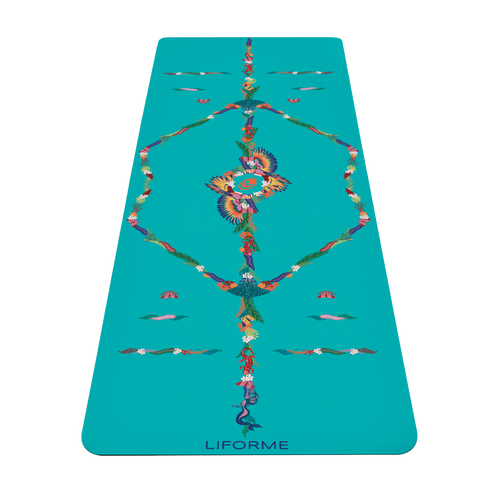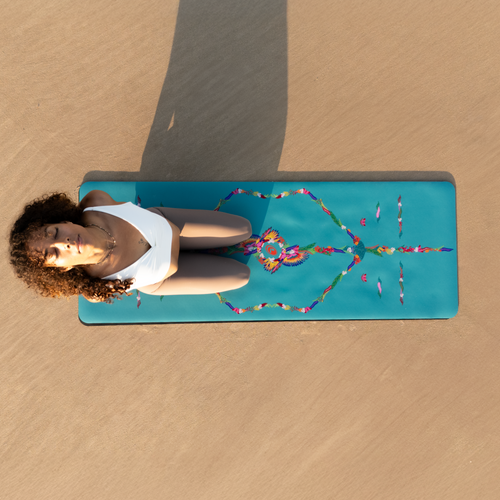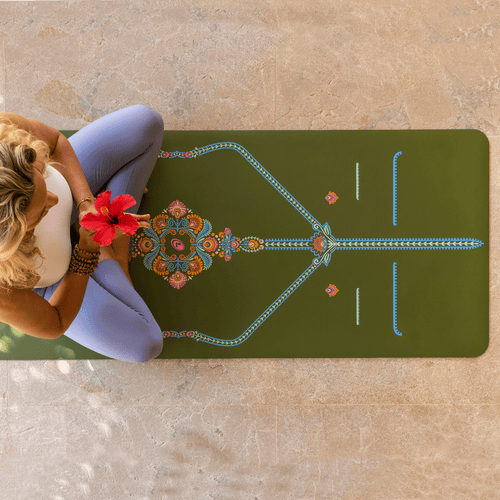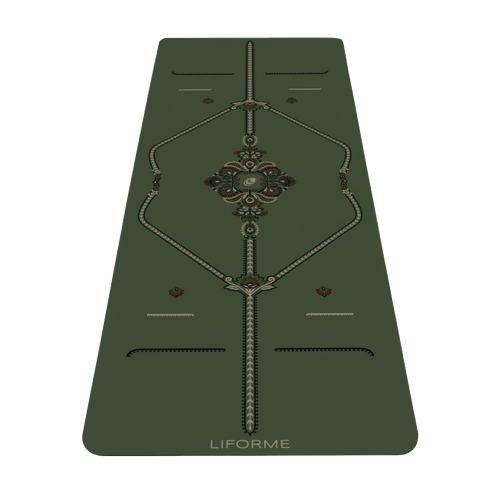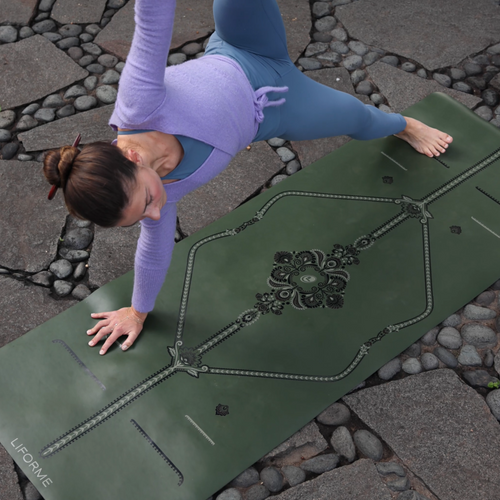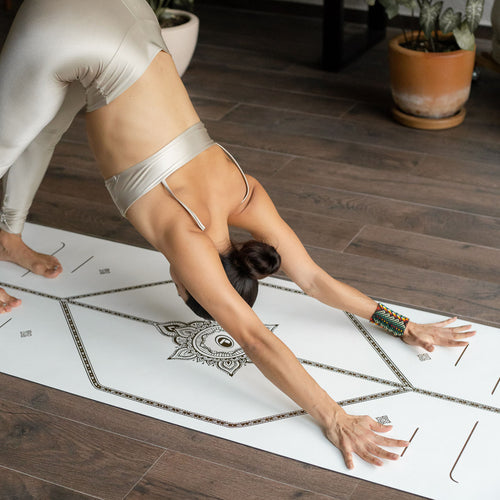Welcome to your pregnant body, which is probably a little different from the body you had previously! During this time of massive change, it’s more important than ever to engage in practices like yoga that help you tune into how you actually feel, rather than how you used to feel or think you should feel.
Doing yoga during your pregnancy also prepares you physically for childbirth and mentally for the journey into parenthood that lies before you. If you’ve done yoga before, let go of any expectations and allow yourself to explore how you feel each day. If you haven’t done yoga before, this is a great time to start connecting with your body and your baby.
The Best Yoga Poses for Pregnancy
Yoga Poses for First Trimester
The first trimester is often characterised by fatigue and nausea. In most cases, it’s all right to practice as usual, but you might not feel like it. Consider this your introduction to following your body’s cues.
Downward Facing Dog (Adho Mukha Svanasana)
Sanskrit Meaning: Adho (Down) Mukha (Face) Svana (Dog) Asana (Pose)
Yoga Level: Beginner
Pose Type: Standing
Why this Pose: If you’ve only got a few poses in you, make sure to include Downward Dog because it’s a quick way to stretch and strengthen your whole body.
Step-by-Step Instructions:
- Begin in hands-and-knees position.
- Curl your toes under and straighten your legs, lifting your butt toward the ceiling to make an inverted V shape with your body.
- Press into your hands, slide your shoulders down your back away from your ears, engage your thighs, and release your heels toward the floor.
- Let your head hang loose.
- Take five to ten deep breaths, focusing your attention on each inhale and exhale.
Garland Pose (Malasana)
Sanskrit Meaning: Mala (Garland) Asana (Pose)
Yoga Level: Beginner
Pose Type: Standing
Why this Pose: It’s never too early to start opening your hips.
Step-by-Step Instructions:
- Stand with your feet separated and your toes turned out.
- Bend your knees to come into a deep squat.
- If your heels come off the mat, put a rolled-up blanket under them so you have something to ground into.
- Send your breath into any areas of discomfort. Keep it brief if you find squatting intense.
Reclined Bound Angle (Supta Baddha Konasana)
Sanskrit Meaning: Supta (Reclined) Baddha (Bound) Kona (Angle) Asana (Pose)
Pose Type: Supine
Yoga Level: Beginner
Why this Pose: Gently opens your hips, groins, and inner thighs.
Step-by-Step Instructions:
- Sit in Baddha Konasana.
- Lie down on your back.
- Use props for support if you like. A block under each knee or a bolster under your spine can feel nice.
- Place one hand on your belly and one hand on your heart. Breathe deeply and connect to your growing baby.
- Do a few Kegels!
Yoga Poses for Second Trimester
After the nausea fades and before things get truly cumbersome, it’s time to get some movement in.
Goddess Pose (Utkata Konasana)
Sanskrit Meaning: Utkata (Powerful) Kona (Angle) Asana (Pose)
Yoga Level: Beginner/Intermediate
Pose Type: Standing
Why this Pose: A little more opening for the hips and groins.
Step-by-Step Instructions:
- From Warrior II (Virabhadrasana II), turn to face the long side of your mat with your legs straight and your feet parallel.
- Turn your toes out and bend your knees, stacking the knees over your ankles.
- Move intuitively, maybe circling your hips, rocking from side to side, lifting one arm and then the other to stretch your sides.
- Come to stillness with your hands in Anjali Mudra at your heart for a few breaths.
Plank Pose (Phalakasana)
Sanskrit Meaning: Phalaka (Plank) Asana (Pose)
Yoga Level: Beginner
Pose Type: Arm Balance
Why this Pose: While you don’t want to do too much abdominal work during pregnancy, a Plank is gentle enough to help you maintain strength. Lowering your knees to the floor always provides a less intense option.
Step-by-Step Instructions:
- Begin in a hands-and-knees position.
- Extend one leg at a time to the back of your mat with your toes tucked under.
- Hold for five to ten breaths, then lower your knees to the mat.
- Repeat two more times.

Legs Up the Wall Pose (Viparita Karani)
Sanskrit Meaning: Viparita (Inversion) Karani (To Do) Asana (Pose)
Pose Type: Inversion
Why this Pose: If you’re still ok lying on your back, Legs Up the Wall is a great way to relieve tired legs and swollen ankles.
Step-by-Step Instructions:
- Come to sit next to a wall with your knees bent and one side of your body touching the wall.
- Roll onto your back, taking your legs up the wall.
- Bring your hands to your belly, tune into your breath, close your eyes, and relax for a few minutes.
- You can also use a bolster and a few blocks to create an incline for your torso if you want to avoid lying flat.
Yoga Poses for Third Trimester
Gentle movement and light stretching to support your comfort.

Cat-Cow Stretch (Marjaryasana-Bitilasana)
Sanskrit Meaning: Marjari (Cat) Asana (Pose) and Bitila (Cow) Asana (Pose)
Yoga Level: Beginner
Pose Type: Kneeling
Why this Pose: Cat-Cow stretches are great throughout your pregnancy for spinal and pelvic integration. All-fours positions can also help move your baby into the optimal position for birth.
Step-by-Step Instructions:
- Begin in a hands-and-knees position with your shoulders over your wrists and your hips over your knees.
- On an inhalation, tip your pelvis forward, drop your belly, and take your gaze upwards.
- On an exhalation, tuck your tail, round your spine toward the ceiling, and take your gaze toward your belly.
- Repeat this cycle of breath and movement for five to ten breaths.
Reverse Warrior (Viparita Virabhadrasana)
Sanskrit Meaning: Viparita (Reversed) Virabhadra (Hindu Warrior) Asana (Pose)
Also Known As: Peaceful Warrior
Yoga Level: Beginner
Pose Type: Standing
Why this Pose: Keep your legs strong while opening your hips and stretching your side body.
Step-by-Step Instructions:
- Begin in Warrior II (Virabhadrasana II). Move your feet away from each other (towards the edge of your mat) for more stability.
- Arc your front arm up toward the ceiling as your back arm slides down your back leg.
- Take your gaze toward your lifted hand.
- Engage Mula Bandha (drawing your perineum up).
- After several breaths, do the other side.
Bound Angle Pose (Baddha Konasana)
Sanskrit Meaning: Baddha (Bound) Kona (Angle) Asana (Pose)
Pose Type: Seated
Yoga Level: Beginner
Why this Pose: Continue to gently open your hips in a seated position.
Step-by-Step Instructions:
- Begin in a comfortable cross-legged position with a blanket or a bolster under your butt for support.
- Bring the soles of your feet together at your midline. The feet can be near your body or further away if that’s more comfortable.
- Bring one hand to your belly and one to your heart. Take ten deep breaths.
Benefits of Prenatal Yoga
Supports Your Changing Body
Listening to your body, one of yoga’s favourite instructions, becomes even more crucial over the 40-odd weeks of pregnancy. Things you used to do with ease may be uncomfortable some days. Poses you once disliked might start to feel like a warm hug.
Throwing everything you thought you knew about your body out the window can be disorienting at first, but ultimately, pregnancy is an amazing lesson in trusting the process, surrendering, and living in the present, all things that will serve you so well once your baby arrives.
Reduces Anxiety
Your body knows how to grow a human, but your mind doesn’t always know how to handle the accompanying anxiety about your baby and the uncertain future. Prenatal Yoga teaches you to anchor your awareness in the present, which can provide perspective and relieve stress.
Stretching and breathing also activate the parasympathetic nervous system, which encourages your body to relax.
Improves Sleep
People love to tell you to get a lot of sleep before your baby arrives, but it’s not always easy. As your pregnancy advances, it can become harder and harder to get some decent shut-eye. Prenatal Yoga soothes your achy body and your overactive mind so you can rest easier. (No cure for the midnight munchies, unfortunately!)
Prepare for Childbirth
Hip openers and Kegels can help your body prepare to give birth, but yoga’s real gifts in this department are mental. Using your breath to keep your mind focused on the present may be the single biggest tool of Prenatal Yoga, and you can practice that in any position.
Pregnancy Yoga Precautions
Pregnancy yoga offers many benefits, but it’s important to practice safely. Here are some things to remember:
- Every pregnant body is different, so listen to yours first and foremost.
- While most Prenatal Yoga poses are safe for most people, ask your doctor if you have any concerns.
- It’s ok to lie on your stomach until your belly begins to protrude.
- If lying on your back becomes uncomfortable, take Savasana on your side or seated.
- Separate your feet more than usual in standing poses for stability and to accommodate your belly.
- Choose open twists over closed twists. When one leg is forward, twist away from it instead of towards it.
- Your body produces a hormone called relaxin that softens your connective tissue to make room for your baby and prepare for delivery. This may allow you to take some stretches deeper than usual, so be careful not to overdo it.
- If you practised inversions comfortably before your pregnancy, it may be ok to continue. Speak to your doctor.
Yoga Poses to Avoid During Pregnancy
While many yoga poses are safe and beneficial during pregnancy, some should be avoided to protect you and your baby:
- Deep backbends and strong abdominal twists that put pressure on your belly.
- Poses involving lying flat on your back for extended periods after the first trimester, as this can reduce blood flow.
- Inversions, unless you have a strong, consistent inversion practice and clearance from your healthcare provider.
- Jumping, bouncing, or rapid transitions that could cause instability or falls.
- Intense balance poses without support also increase the risk of falling.
Always listen to your body, modify poses as needed, and consult your healthcare provider if you’re unsure.
Do What Works for You
The best pregnancy yoga poses are the ones that make you feel comfortable and in tune with your body. If our suggestions don’t work for you, you can explore other poses you know, move intuitively on your mat, or try Prenatal Yoga classes, which are also a great place to meet other expectant parents. Let yoga support your pregnancy in the way that works best for you.
Prenatal Yoga FAQs
Is yoga safe during pregnancy?
Yes, prenatal yoga is generally safe for most pregnant people and can offer many benefits. However, always consult your healthcare provider before starting or continuing yoga during pregnancy.
Can I start yoga if I’ve never done it before and I’m pregnant?
Absolutely! Pregnancy is a great time to begin gentle yoga, helping you connect with your changing body and your baby.
What are the best yoga poses for pregnancy?
Gentle hip openers, standing poses like Warrior II, supported seated poses, and breathing exercises are excellent.
Are there any poses I should avoid during pregnancy?
Yes, avoid deep backbends, strong twists, lying flat on your back after the first trimester, intense inversions without experience, and rapid movements that risk falling.
How often should I practice prenatal yoga?
Aim for 2-3 gentle sessions per week or as your body feels comfortable. Regular practice supports physical strength and mental well-being during pregnancy, but remember to always consult with your doctor.












